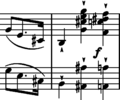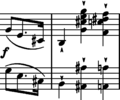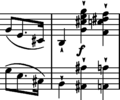



Issues : Centrally placed marks
|
b. 1
|
composition: Op. 11, Concerto in E minor, Mvt I
..
The manner the category imprint: Graphic ambiguousness; Differences between sources issues: Centrally placed marks |
||||||||
|
b. 16
|
composition: Op. 11, Concerto in E minor, Mvt I
..
The dynamic mark is written in Atut between two chords, so that in the majority of the sources it was assigned to the 3rd beat of the bar. According to us, however, the texture clearly indicates that the new dynamics should be valid already from the 1st chord, which is confirmed by the indications in the orchestral parts. Therefore, the notation of Atut is an example of a manner of placing marks within the range of their validity, sometimes used by Chopin. Due to this reason, in the main text we give category imprint: Interpretations within context; Differences between sources issues: GE revisions , Centrally placed marks |
||||||||
|
b. 45
|
composition: Op. 11, Concerto in E minor, Mvt I
..
The position of the category imprint: Editorial revisions issues: Centrally placed marks |
||||||||
|
b. 177
|
composition: Op. 11, Concerto in E minor, Mvt I
..
One can ponder whether the placement of the staccato indication only just in the 2nd half of the bar is not an example of the Chopinesque manner of placing indications within their range of validity. In other words, whether one should not perform the entire chromatic sequence in this bar staccato. According to us, no – such placed indication most probably means that the first few notes are to be performed legato and then the articulation is to be gradually changed, so that the last few notes are clearly performed staccato. There is a similar situation in bar 532. category imprint: Source & stylistic information issues: Centrally placed marks |
||||||||
|
b. 501
|
composition: Op. 11, Concerto in E minor, Mvt I
..
The fact of assigning category imprint: Interpretations within context; Differences between sources issues: GE revisions , Centrally placed marks |


 in
in 


 in
in 




 ), or from the semiquaver tremolando. In a similar context in bars 99 and 111,
), or from the semiquaver tremolando. In a similar context in bars 99 and 111, 

